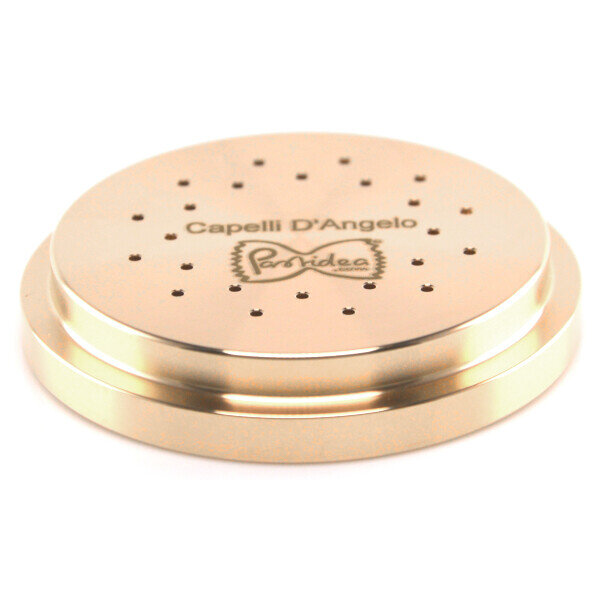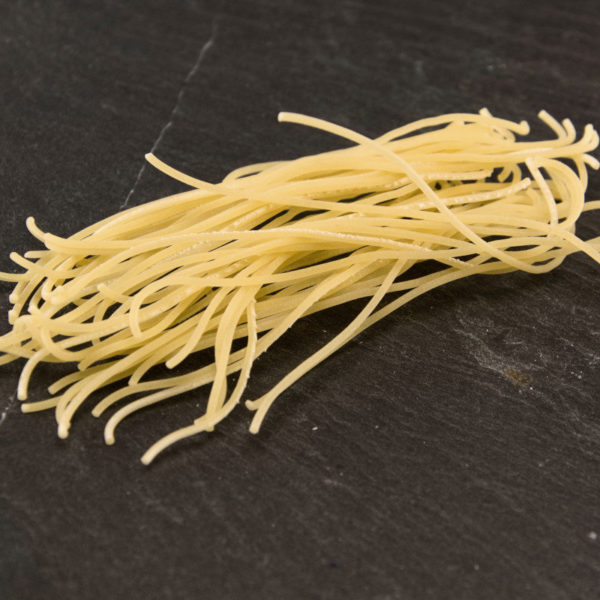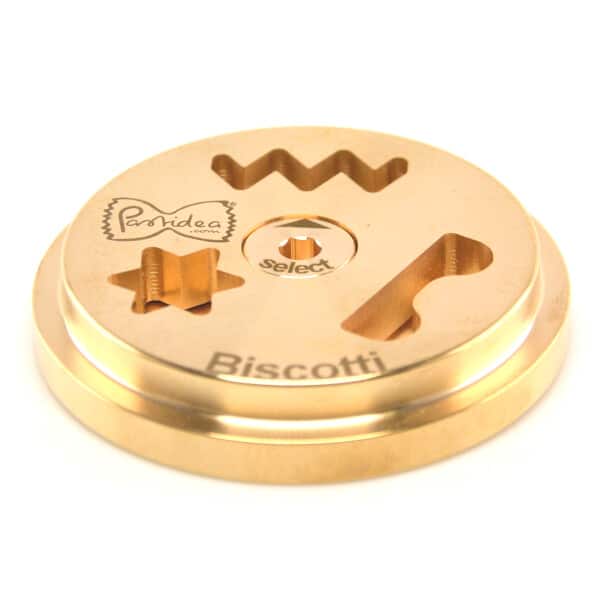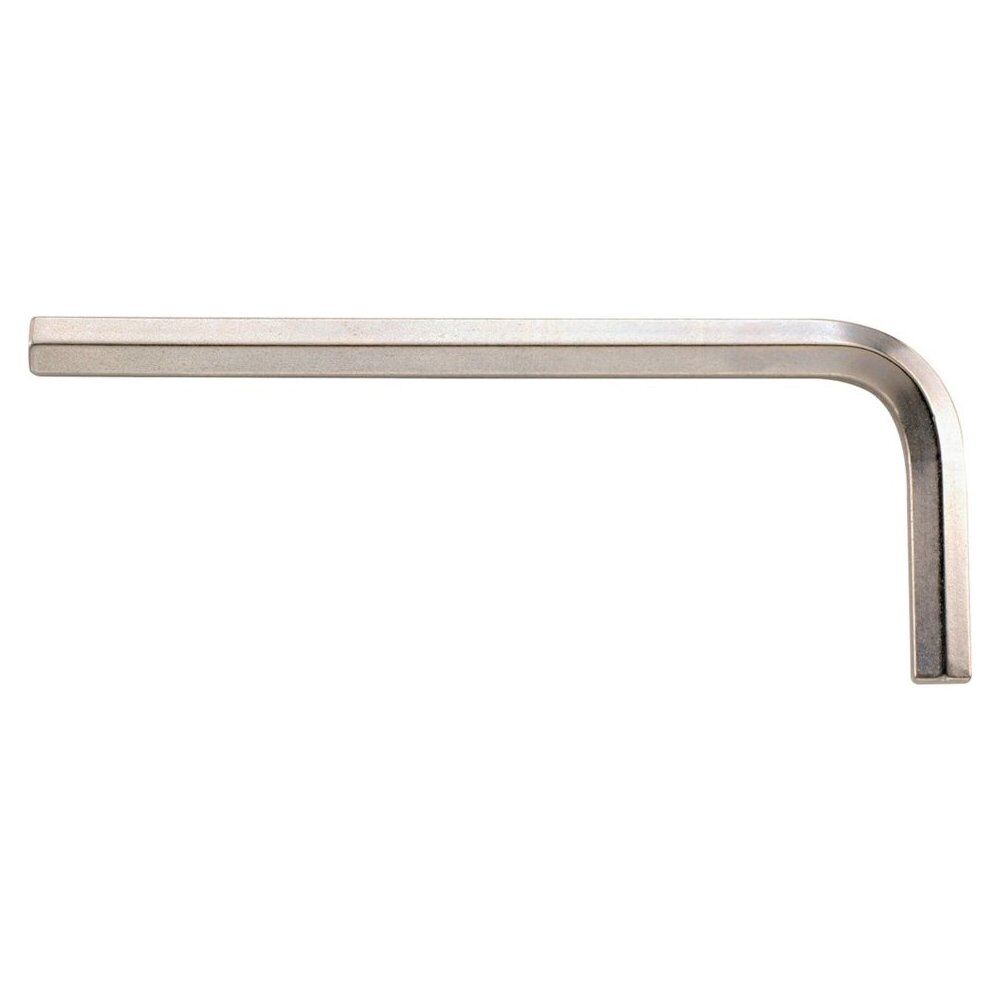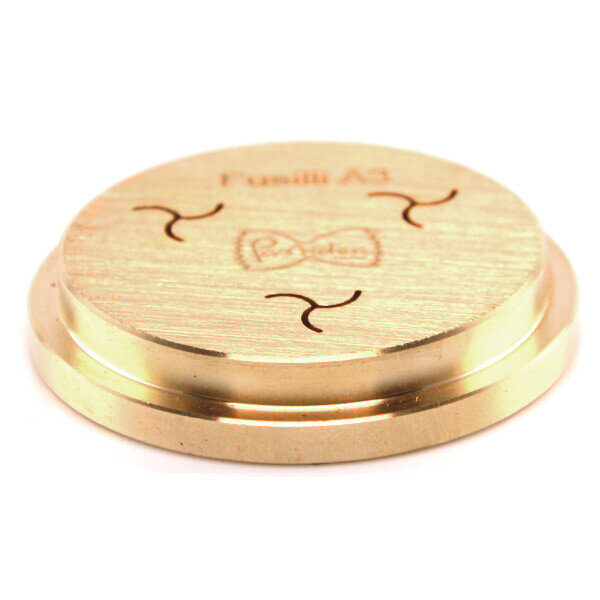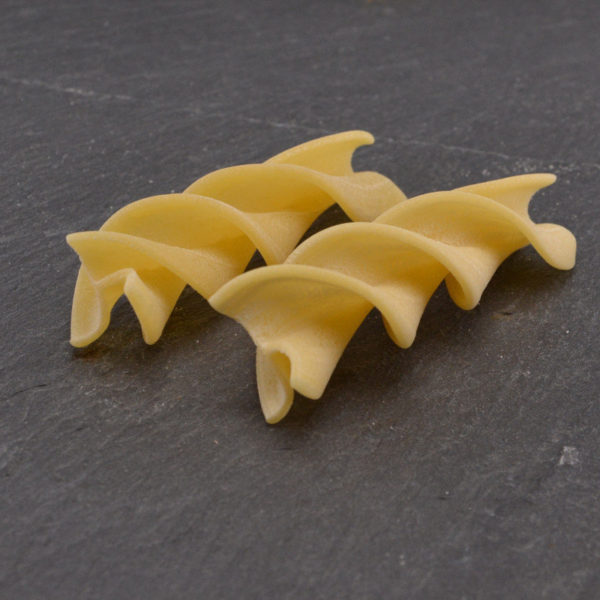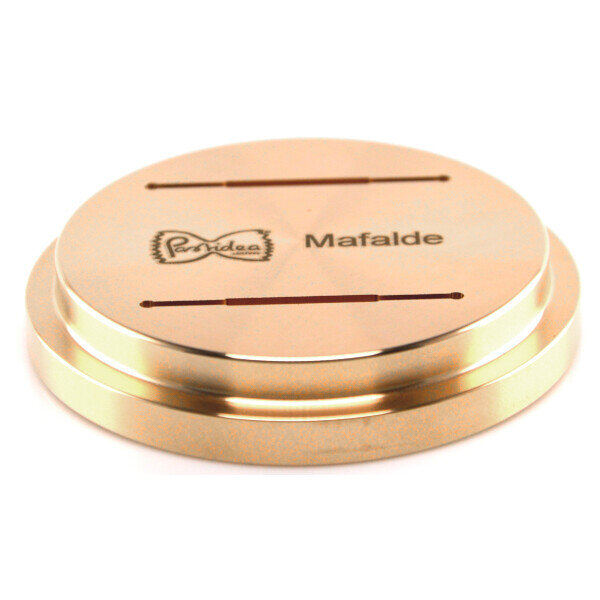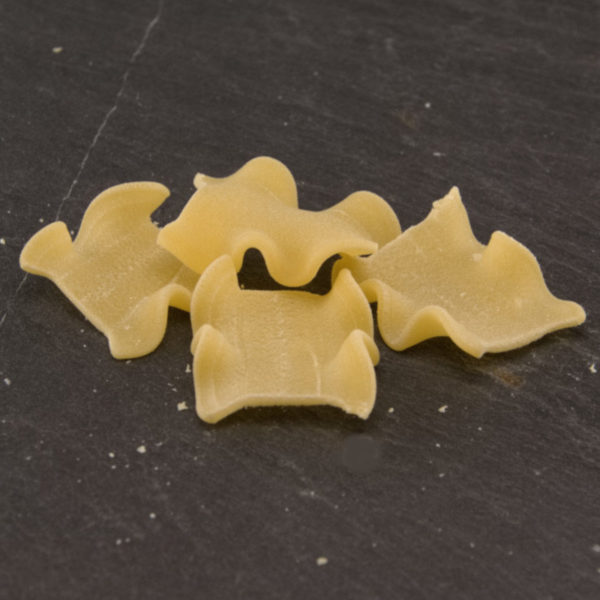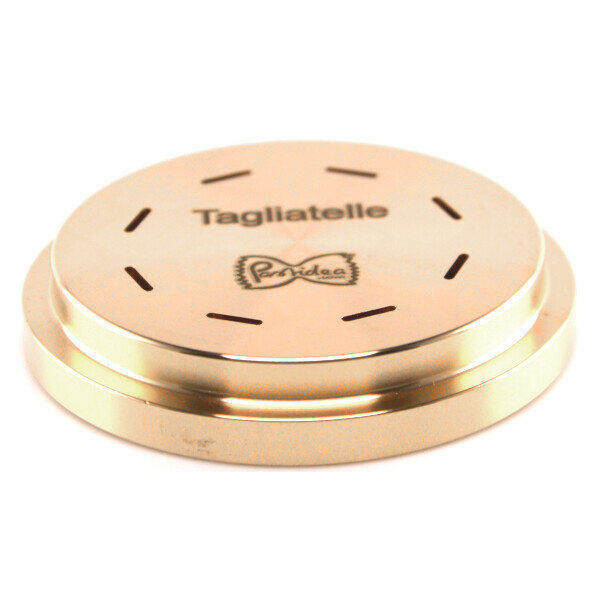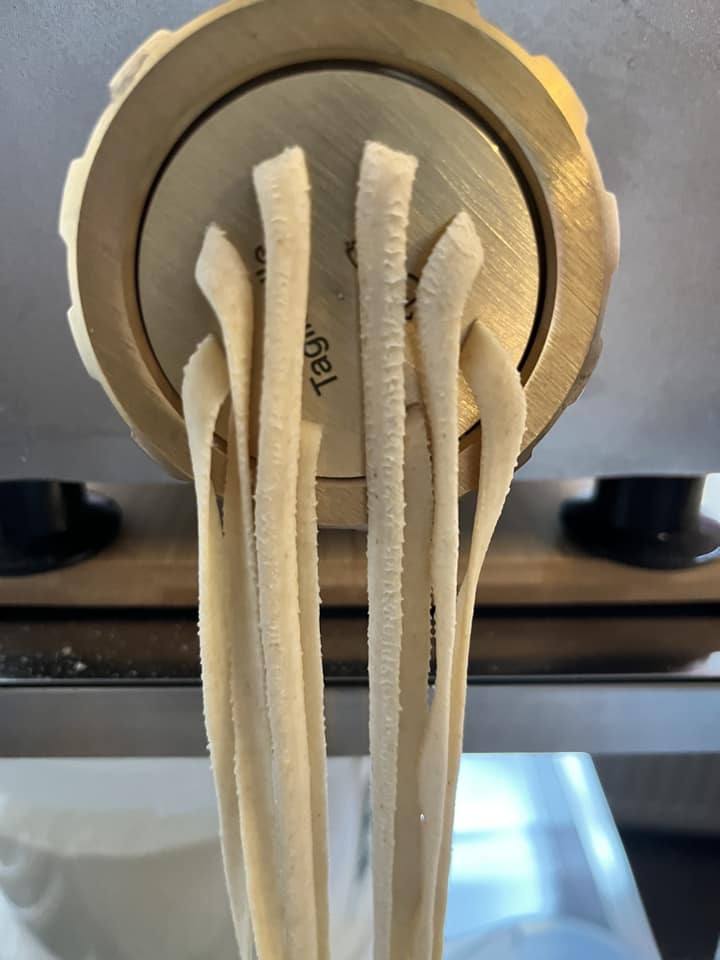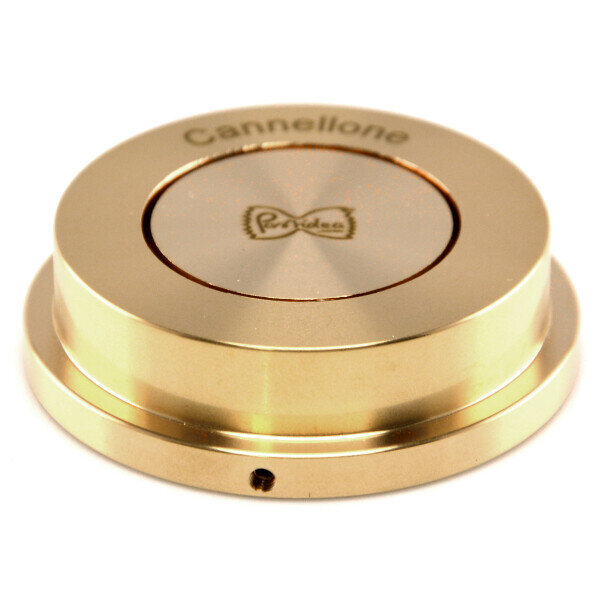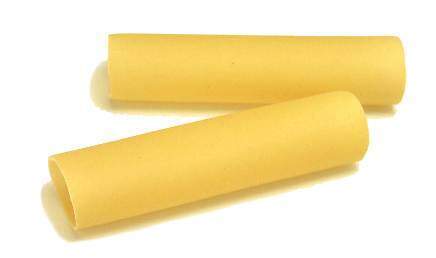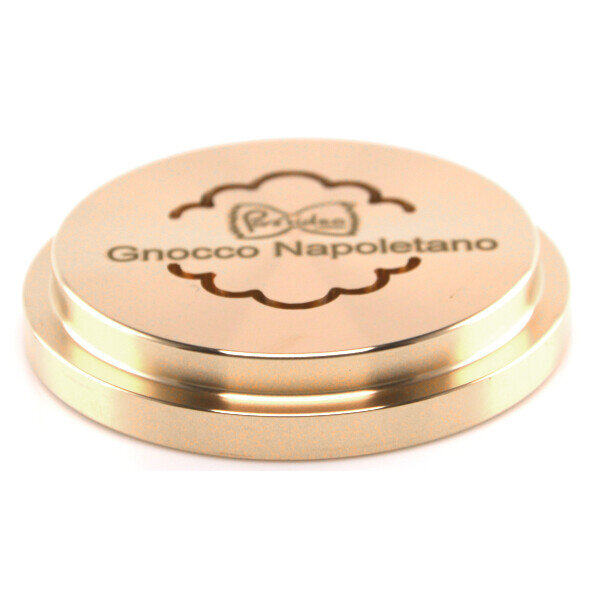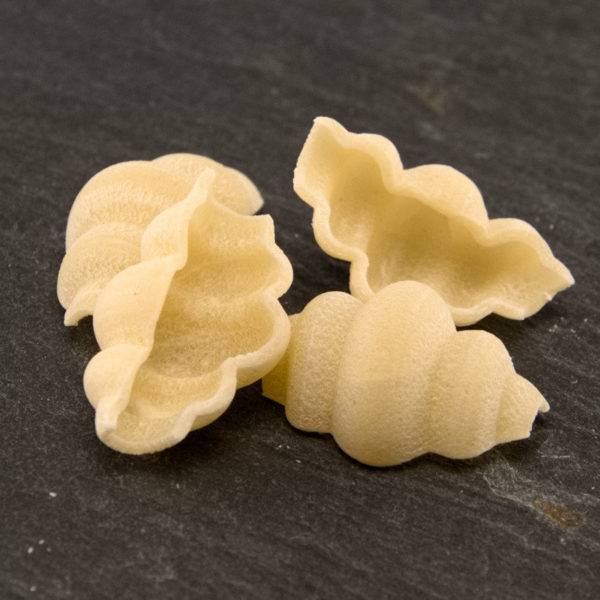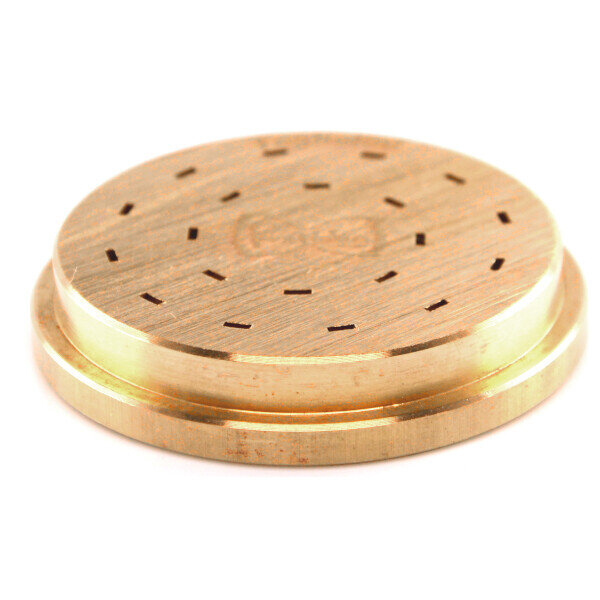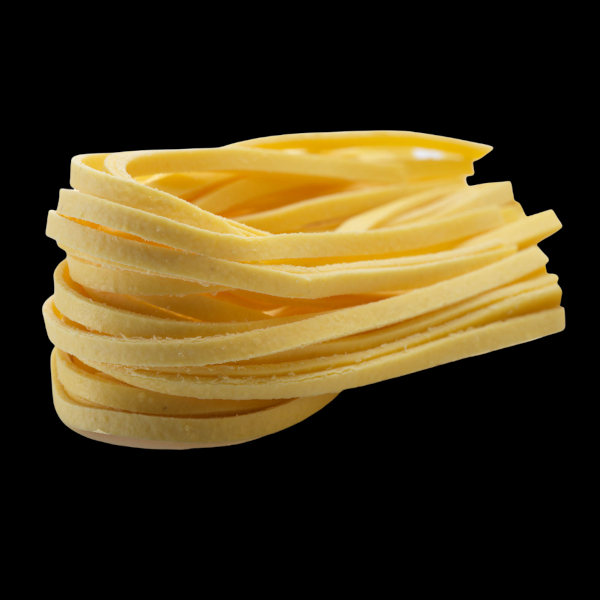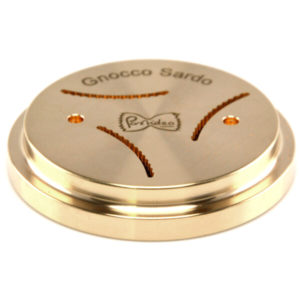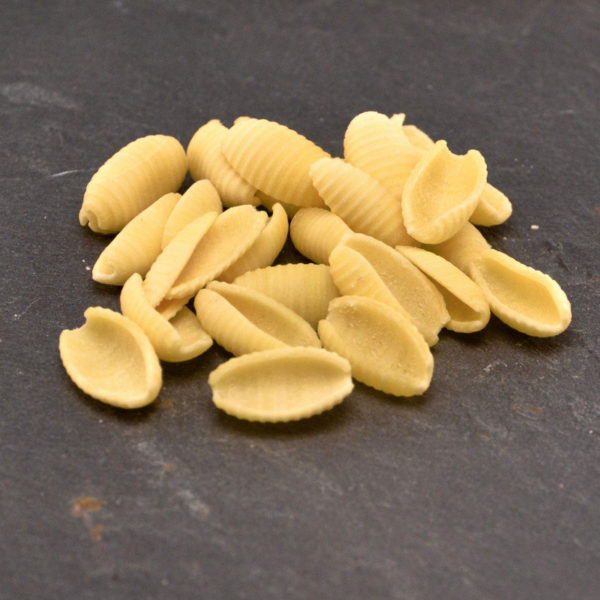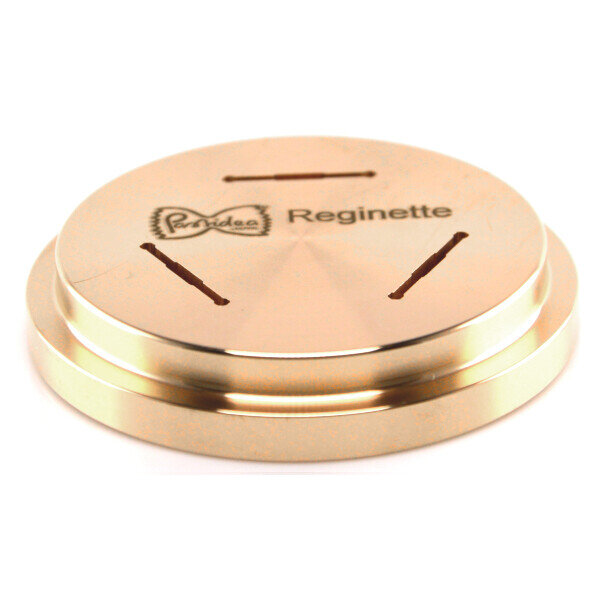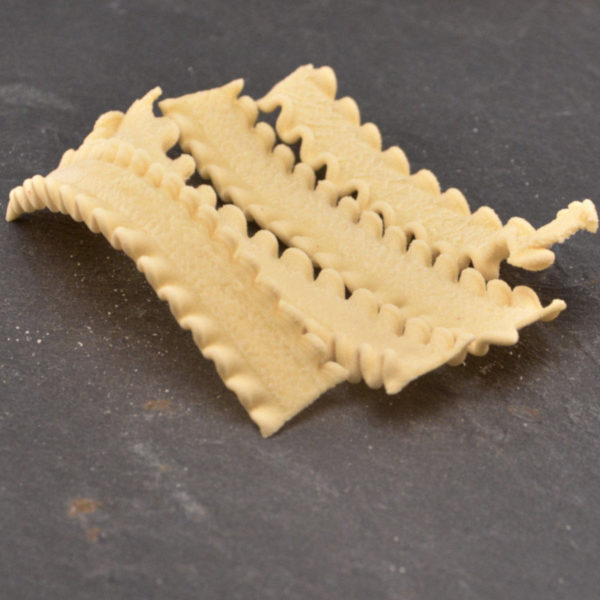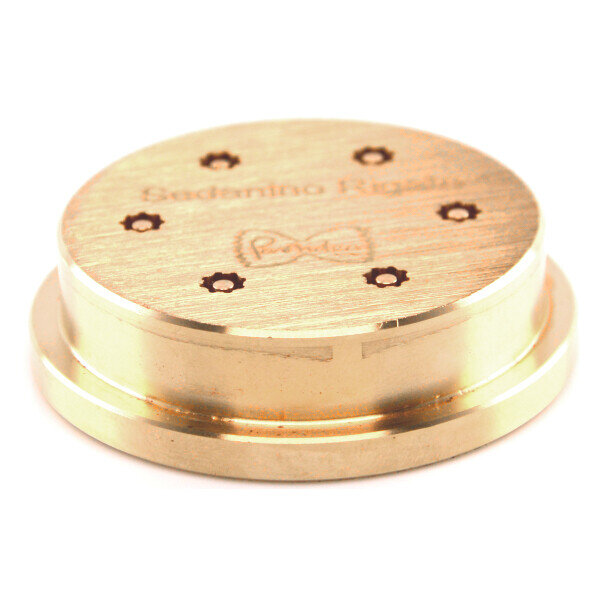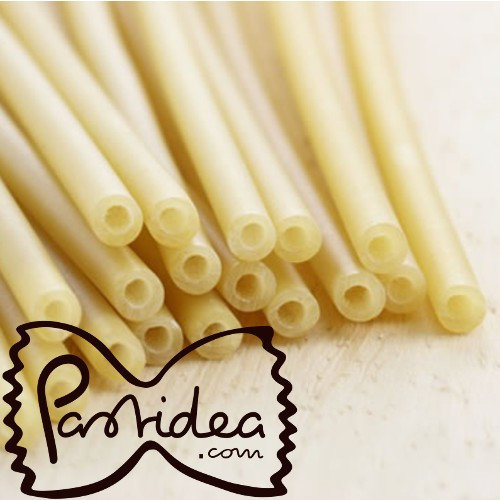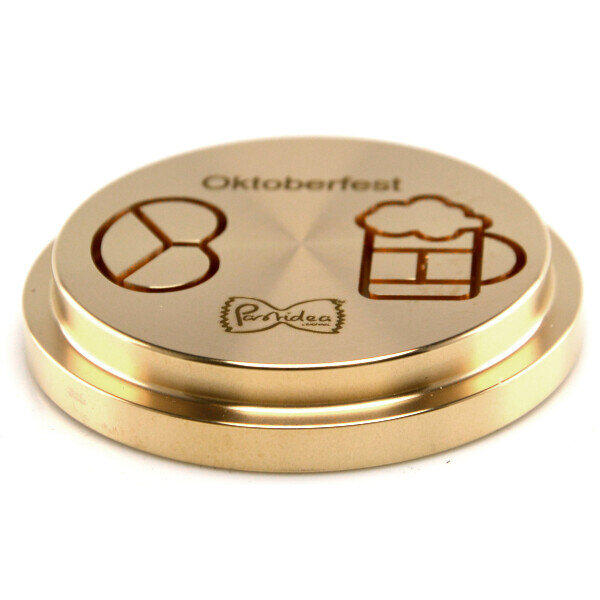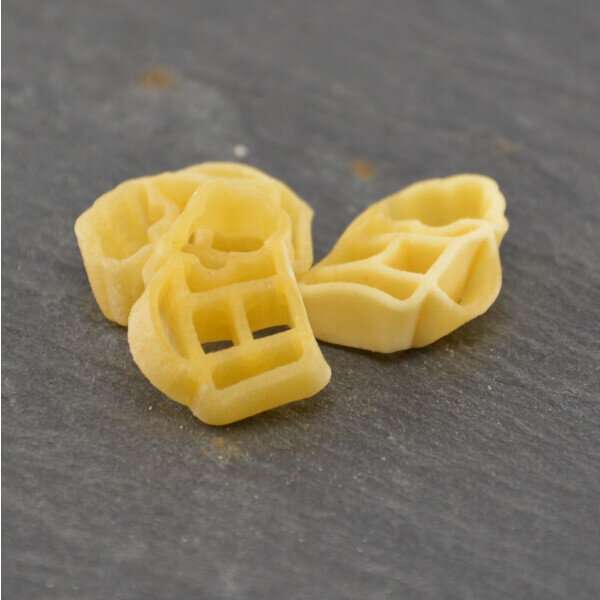40,90 € incl. VAT plus shipping costs
VAT included
excl. Shipping Rate
Bronze die Capelli d'Angelo This noodle gets its name because the spaghetti comes out so fine that it resembles angel hair. This noodle is perfect for Asian wok dishes or as an addition to soups. Other names for this pasta are Capellini (Capello = hair), Capelvenere, Maccheroni ciociari or Ramiccia. But be careful: the noodle is too fine for spaghetti. If you want to eat it as spaghetti with sauce, we recommend the slightly thicker (but still very tender) spaghetti 1,6 mm. Did you know that angel hair pasta made from egg batter used to be served to young mothers from good families after giving birth? It was hoped that it would be good for milk production. It sure tasted good! Diameter of die: 56 mm Pasta insert for the following professional pasta machines: La Fattorina Fimar MPF 1.5 Fimar PF15E Arcobaleno AEX-10 Bartscher GGM-Gastro NMF5 No adapter or similar is required. The die fits directly into the above-mentioned pasta machines. Why bronze: Bronze dies were the traditional way of making pasta. The pasta made “al bronzo” can only be found rarely and usually only in selected delicatessens. By pressing the pasta dough through the bronze matrices, the surface of the pasta is slightly roughened at the same time, making the pasta easier to grip. This allows the pasta to better absorb the sauce, flavors and spices later on. Would you like to learn more about bronze matrices? Then we recommend this article to you here. Recipe: It is recommended to use durum wheat semolina, enough cold liquid such as water and/or egg. The dough should be kneaded for about 8-10 minutes, this is the only way the gluten from the durum wheat can fully develop. The result should be a moist, crumbly dough. You can find a standard recipe for our matrices here. The matrices can also be used to produce gluten-free pasta. Storage: Do you have several bronze matrices and are looking for storage to protect the matrix from dust and darkening caused by light? Then we recommend our storage systems to you here .
40,90 € incl. VAT plus shipping costs
VAT included
excl. Shipping Rate
Bronze die Biscotti / Biscuits / Cookies This biscuit mold is versatile. A few application examples: a.) Classic shortbread cookies: Make the dough externally (preferably the family recipe as always), cool the dough in the refrigerator so that it hardens. Let the chilled dough pass through the die and bake. b.) Grissini dough: Here too, make the dough externally, only put it into the machine for output. c.) Shortcrust pastry/cookie cutter dough: I have also had good experiences with this. To do this, make the cookie dough externally, cool it, then put it into the machine for output. A bowl of these little shapes is a delight. Size: 39 mm Thickness: 1,2 mm Diameter die: 56 mm Pasta insert for the following professional pasta machines: La Fattorina Fimar MPF 1.5 Fimar PF15E Arcobaleno AEX-10 Bartscher GGM-Gastro NMF5 No adapter or similar is required. The die fits directly into the above-mentioned pasta machines. Why bronze: Bronze dies were the traditional way of making pasta. The pasta made “al bronzo” can only be found rarely and usually only in selected delicatessens. By pressing the pasta dough through the bronze matrices, the surface of the pasta is slightly roughened at the same time, making the pasta easier to grip. This allows the pasta to better absorb the sauce, flavors and spices later on. Would you like to learn more about bronze matrices? Then we recommend this article to you here. Recipe: It is recommended to use durum wheat semolina, enough cold liquid such as water and/or egg. The dough should be kneaded for about 8-10 minutes, this is the only way the gluten from the durum wheat can fully develop. The result should be a moist, crumbly dough. You can find a standard recipe for our matrices here. The matrices can also be used to produce gluten-free pasta. Storage: Do you have several bronze matrices and are looking for storage to protect the matrix from dust and darkening caused by light? Then we recommend our storage systems to you here .
40,90 € incl. VAT plus shipping costs
VAT included
excl. Shipping Rate
Bronze die Fusilli A3 One of the most famous noodles in Germany is fusilli. They are often called Spirelli, Rotini and rarely Eliche. The word fusilli comes from the Italian word “fuso”, which means spindle. In manual fusilli production, spaghetti is still wrapped around a spindle. According to legend, fusilli were invented at the court in Florence around 1550. The cook's son sat under the kitchen table and played with fallen pasta scraps that he wrapped around a knitting needle. These were the first fusillis. Not quite as clear, but much more likely, is the story that the Fusillis originated in southern Italy. At some point, spaghetti began to be rolled up in a spiral for drying, as the rotation made it much easier to dry and store. What is undisputed is that the twists mean that the sauce combines particularly well with the pasta. Fusillis are easy to dry. Fusillis are available with 2, 3 or 5 wings. You can see how many propeller blades the Fusilli has by the die shape and also the die name. Ie a Fusilli A2 has two wings, an A3 has 3 wings, an A5 has 5 wings. Diameter of die: 56 mm Pasta insert for the following professional pasta machines: La Fattorina Fimar MPF 1.5 Fimar PF15E Arcobaleno AEX-10 Bartscher GGM-Gastro NMF5 No adapter or similar is required. The die fits directly into the above-mentioned pasta machines. Why bronze: Bronze dies were the traditional way of making pasta. The pasta made “al bronzo” can only be found rarely and usually only in selected delicatessens. By pressing the pasta dough through the bronze matrices, the surface of the pasta is slightly roughened at the same time, making the pasta easier to grip. This allows the pasta to better absorb the sauce, flavors and spices later on. Would you like to learn more about bronze matrices? Then we recommend this article to you here. Recipe: It is recommended to use durum wheat semolina, enough cold liquid such as water and/or egg. The dough should be kneaded for about 8-10 minutes, this is the only way the gluten from the durum wheat can fully develop. The result should be a moist, crumbly dough. You can find a standard recipe for our matrices here. The matrices can also be used to produce gluten-free pasta. Storage: Do you have several bronze matrices and are looking for storage to protect the matrix from dust and darkening caused by light? Then we recommend our storage systems to you here .
40,90 € incl. VAT plus shipping costs
VAT included
excl. Shipping Rate
Mafalde / Manfredini bronze die Tip: Mafalde and Reginette are very similar pastas. They both have a wavy edge that catches the sauce particularly well. The difference is in the width. The Reginette are 1,8 cm wide, the Mafalde 2,8 cm wide. Reginette are mainly eaten long. Due to the impressive width of the Mafalde, they also cut a good figure as a side dish. While Reginette translates as “little queen”, the Manfredi or Manfredini (who are also known under the name Mafalde) owe their name to a king: They were named after Manfred of Swabia, who was King of Sicily from 1258 to 1266 had his reputation as a sweet tooth. The mafalde were traditionally served with ricotta, the wavy edge helps the ricotta to hold better. Diameter of die: 56 mm Pasta insert for the following professional pasta machines: La Fattorina Fimar MPF 1.5 Fimar PF15E Arcobaleno AEX-10 Bartscher GGM-Gastro NMF5 No adapter or similar is required. The die fits directly into the above-mentioned pasta machines. Why bronze: Bronze dies were the traditional way of making pasta. The pasta made “al bronzo” can only be found rarely and usually only in selected delicatessens. By pressing the pasta dough through the bronze matrices, the surface of the pasta is slightly roughened at the same time, making the pasta easier to grip. This allows the pasta to better absorb the sauce, flavors and spices later on. Would you like to learn more about bronze matrices? Then we recommend this article to you here. Recipe: It is recommended to use durum wheat semolina, enough cold liquid such as water and/or egg. The dough should be kneaded for about 8-10 minutes, this is the only way the gluten from the durum wheat can fully develop. The result should be a moist, crumbly dough. You can find a standard recipe for our matrices here. The matrices can also be used to produce gluten-free pasta. Storage: Do you have several bronze matrices and are looking for storage to protect the matrix from dust and darkening caused by light? Then we recommend our storage systems to you here .
40,90 € incl. VAT plus shipping costs
VAT included
excl. Shipping Rate
Bronze tagliatelle die 6mm Tagliatelle are traditionally made with eggs in Emilia Romagna, Italy. The name comes from the Italian verb “tagliare”, meaning “to cut”. This means that tagliatelle are pasta cut into strips. Tagliatelle in general are always between 6 and 8 mm wide. In Germany they are more often around 6 mm wide In Italy, it is usually around 8 mm wide. This means that this tagliatelle die with 6 mm is more like the pasta you find in the shop in Germany. While in Germany Bolognese is traditionally eaten as “Spaghetti Bolognese”, in Italy it is traditionally eaten as a Bolognese sauce together with tagliatelle. Try it out! Diameter of die: 56 mm Pasta insert for the following professional pasta machines: La Fattorina Fimar MPF 1.5 Fimar PF15E Arcobaleno AEX-10 Bartscher GGM-Gastro NMF5 No adapter or similar is required. The die fits directly into the above-mentioned pasta machines. Why bronze: Bronze dies were the traditional way of making pasta. The pasta made “al bronzo” can only be found rarely and usually only in selected delicatessens. By pressing the pasta dough through the bronze matrices, the surface of the pasta is slightly roughened at the same time, making the pasta easier to grip. This allows the pasta to better absorb the sauce, flavors and spices later on. Would you like to learn more about bronze matrices? Then we recommend this article to you here. Recipe: It is recommended to use durum wheat semolina, enough cold liquid such as water and/or egg. The dough should be kneaded for about 8-10 minutes, this is the only way the gluten from the durum wheat can fully develop. The result should be a moist, crumbly dough. You can find a standard recipe for our matrices here. The matrices can also be used to produce gluten-free pasta. Storage: Do you have several bronze matrices and are looking for storage to protect the matrix from dust and darkening caused by light? Then we recommend our storage systems to you here .
45,90 € incl. VAT plus shipping costs
VAT included
excl. Shipping Rate
Bronze cannelloni die In the Italian-American region they are also spoken Manicotti man-uh-cot-tee 🙂 A canello translated from Italian is a “tube”. The -one at the end, i.e. cannellone, makes it a big, thick tube. We owe the cannelloni to Nicola Federico, who invented the large, thick tubes in 1907 while working as a chef in a restaurant on the Amalfi Coast. Cannelloni are now known not only throughout Italy but all over the world. The most common method of preparation is certainly similar to that of a classic Bolognese with Bolognese and Bechamel. But ultimately you can prepare them however you like, whether with meat, vegetarian or vegan. What all recipes have in common: The cannelloni are baked “al forno” in the oven. You can find my favorite cannelloni recipe with spinach and ricotta here: https://www.cookingchef-freun.de/?p=12470 And it's not just the filling ingredients that are flexible. Also with the ingredients for the pasta dough. For example, if you follow a gluten-free diet, you won't be able to easily find cannelloni in the supermarket. With this die you can also eat gluten-free cannelloni etc. Diameter of die: 56 mm Pasta insert for the following professional pasta machines: La Fattorina Fimar MPF 1.5 Fimar PF15E Arcobaleno AEX-10 Bartscher GGM-Gastro NMF5 No adapter or similar is required. The die fits directly into the above-mentioned pasta machines. Why bronze: Bronze dies were the traditional way of making pasta. The pasta made “al bronzo” can only be found rarely and usually only in selected delicatessens. By pressing the pasta dough through the bronze matrices, the surface of the pasta is slightly roughened at the same time, making the pasta easier to grip. This allows the pasta to better absorb the sauce, flavors and spices later on. Would you like to learn more about bronze matrices? Then we recommend this article to you here. Recipe: It is recommended to use durum wheat semolina, enough cold liquid such as water and/or egg. The dough should be kneaded for about 8-10 minutes, this is the only way the gluten from the durum wheat can fully develop. The result should be a moist, crumbly dough. You can find a standard recipe for our matrices here. The matrices can also be used to produce gluten-free pasta. Storage: Do you have several bronze matrices and are looking for storage to protect the matrix from dust and darkening caused by light? Then we recommend our storage systems to you here .
52,40 € incl. VAT plus shipping costs
VAT included
excl. Shipping Rate
Bronze Gnocco Napoletano die This pasta use for pasta production is gnocchi/nocken/nockerl from the Campania region with the capital Naples. The shape was inspired by classic potato gnocchi. The Gnoccho Napoletano is the small version (there are two larger versions), which is a real all-rounder: whether it's a pasta salad, a side dish or a main course with sauce... This pasta almost always works. This format is also easy to dry. Size: 25,5 mm Thickness: 1,2 mm Diameter die: 56 mm Pasta insert for the following professional pasta machines: La Fattorina Fimar MPF 1.5 Fimar PF15E Arcobaleno AEX-10 Bartscher GGM-Gastro NMF5 No adapter or similar is required. The die fits directly into the above-mentioned pasta machines. Why bronze: Bronze dies were the traditional way of making pasta. The pasta made “al bronzo” can only be found rarely and usually only in selected delicatessens. By pressing the pasta dough through the bronze matrices, the surface of the pasta is slightly roughened at the same time, making the pasta easier to grip. This allows the pasta to better absorb the sauce, flavors and spices later on. Would you like to learn more about bronze matrices? Then we recommend this article to you here. Recipe: It is recommended to use durum wheat semolina, enough cold liquid such as water and/or egg. The dough should be kneaded for about 8-10 minutes, this is the only way the gluten from the durum wheat can fully develop. The result should be a moist, crumbly dough. You can find a standard recipe for our matrices here. The matrices can also be used to produce gluten-free pasta. Storage: Do you have several bronze matrices and are looking for storage to protect the matrix from dust and darkening caused by light? Then we recommend our storage systems to you here .
40,90 € incl. VAT plus shipping costs
VAT included
excl. Shipping Rate
Die made of bronze Tagliolini Tagliolini are wafer-thin tagliatelle noodles. Wider than capellini but not as wide as tagliatelle. And because they are only 3 mm wide and only 1 mm thin, they are extremely delicate and leave a very nice, delicate mouthfeel when eaten. The name comes from the Italian verb “tagliare”. Tagliare means “to cut” and the -ini at the end means that it is something small. So cut a strip of dough into many very small strips. This pasta shape is particularly widespread in the Italian regions of Molise, Piedmont and Emiglia-Romagna. But in Piedmont they have a different name, where they are mainly found under the name tajarin. The tagliolini are prepared with a dough made from durum wheat semolina and eggs. Diameter of die: 56 mm Pasta insert for the following professional pasta machines: La Fattorina Fimar MPF 1.5 Fimar PF15E Arcobaleno AEX-10 Bartscher GGM-Gastro NMF5 No adapter or similar is required. The die fits directly into the above-mentioned pasta machines. Why bronze: Bronze dies were the traditional way of making pasta. The pasta made “al bronzo” can only be found rarely and usually only in selected delicatessens. By pressing the pasta dough through the bronze matrices, the surface of the pasta is slightly roughened at the same time, making the pasta easier to grip. This allows the pasta to better absorb the sauce, flavors and spices later on. Would you like to learn more about bronze matrices? Then we recommend this article to you here. Recipe: It is recommended to use durum wheat semolina, enough cold liquid such as water and/or egg. The dough should be kneaded for about 8-10 minutes, this is the only way the gluten from the durum wheat can fully develop. The result should be a moist, crumbly dough. You can find a standard recipe for our matrices here. The matrices can also be used to produce gluten-free pasta. Storage: Do you have several bronze matrices and are looking for storage to protect the matrix from dust and darkening caused by light? Then we recommend our storage systems to you here .
57,90 € incl. VAT plus shipping costs
VAT included
excl. Shipping Rate
Bronze die Gnocco Sardo / Sardinian Gnocchi / Malloreddus Gnocco sardo are small, fluted mussels. The name already gives it away. It is a type of gnocchi that people like to eat in Sardinia. Attention: In Sardinia, these gnocchi are always prepared without eggs (i.e. only durum wheat and water). In other areas of Italy people are more tolerant. These noodles are also known under the name Malloreddus. Because the pasta is pulled through a bronze die, the result is a very slightly roughened surface. This means the sauce can be absorbed particularly well. Cavatelli are very similar to Gnocco Sardo. The difference lies in the fine stripes on the surface, while the cavatelli are smooth. Size: 19 mm Thickness: 1,2 mm Diameter die: 56 mm Pasta insert for the following professional pasta machines: La Fattorina Fimar MPF 1.5 Fimar PF15E Arcobaleno AEX-10 Bartscher GGM-Gastro NMF5 No adapter or similar is required. The die fits directly into the above-mentioned pasta machines. Why bronze: Bronze dies were the traditional way of making pasta. The pasta made “al bronzo” can only be found rarely and usually only in selected delicatessens. By pressing the pasta dough through the bronze matrices, the surface of the pasta is slightly roughened at the same time, making the pasta easier to grip. This allows the pasta to better absorb the sauce, flavors and spices later on. Would you like to learn more about bronze matrices? Then we recommend this article to you here. Recipe: It is recommended to use durum wheat semolina, enough cold liquid such as water and/or egg. The dough should be kneaded for about 8-10 minutes, this is the only way the gluten from the durum wheat can fully develop. The result should be a moist, crumbly dough. You can find a standard recipe for our matrices here. The matrices can also be used to produce gluten-free pasta. Storage: Do you have several bronze matrices and are looking for storage to protect the matrix from dust and darkening caused by light? Then we recommend our storage systems to you here .
40,90 € incl. VAT plus shipping costs
VAT included
excl. Shipping Rate
Bronze Reginette die “Reginette” means something like “little queen” in German. We think this noble name fits perfectly. Tip: Mafalde and Reginette are very similar pastas. They both have a wavy edge that catches the sauce particularly well. The difference is in the width. The reginette are 1,8 cm wide, the bronze mafalde 2,8 cm. Reginette are mainly eaten long. Mafalde, on the other hand, can often be found cut short. Diameter of die: 56 mm Pasta insert for the following professional pasta machines: La Fattorina Fimar MPF 1.5 Fimar PF15E Arcobaleno AEX-10 Bartscher GGM-Gastro NMF5 No adapter or similar is required. The die fits directly into the above-mentioned pasta machines. Why bronze: Bronze dies were the traditional way of making pasta. The pasta made “al bronzo” can only be found rarely and usually only in selected delicatessens. By pressing the pasta dough through the bronze matrices, the surface of the pasta is slightly roughened at the same time, making the pasta easier to grip. This allows the pasta to better absorb the sauce, flavors and spices later on. Would you like to learn more about bronze matrices? Then we recommend this article to you here. Recipe: It is recommended to use durum wheat semolina, enough cold liquid such as water and/or egg. The dough should be kneaded for about 8-10 minutes, this is the only way the gluten from the durum wheat can fully develop. The result should be a moist, crumbly dough. You can find a standard recipe for our matrices here. The matrices can also be used to produce gluten-free pasta. Storage: Do you have several bronze matrices and are looking for storage to protect the matrix from dust and darkening caused by light? Then we recommend our storage systems to you here .
40,90 € incl. VAT plus shipping costs
VAT included
excl. Shipping Rate
Bronze Bucatini die Bucatini is very large spaghetti, but with a hole in the middle (bucatini has the Italian word buco = hole). The Italians are very proud of their bucatini, you can find them all over Italy. Many say they come from Sicily, but I have also heard in the Rome area that they are typical of the region. Bucatini are very long pasta, if you let them out 30 cm long you are doing everything right. They are often served with rich sauces such as an Amatriciana or a Carbonara. But you can also find many vegetable sauces, for example with broccoli, on the menu in Italian restaurants. There is another special feature that you should know: In Germany people eat macaroni or macaroni with a smaller diameter than in Italy, 0,3 - 0,5 cm diameter is the average for macaroni in Germany (in Italy, however, approx. 1 cm ). This Italian bucatini is very close to the German macaroni that is so popular with children. You just have to cut them shorter. And you shouldn't talk about it too loudly, because Italians don't like the change in pasta terms. But here we are among ourselves, please don't tell anyone else 🙂 Diameter of die: 56 mm Pasta insert for the following professional pasta machines: La Fattorina Fimar MPF 1.5 Fimar PF15E Arcobaleno AEX-10 Bartscher GGM-Gastro NMF5 No adapter or similar is required . The die fits directly into the above-mentioned pasta machines. Why bronze: Bronze dies were the traditional way of making pasta. The pasta made “al bronzo” can only be found rarely and usually only in selected delicatessens. By pressing the pasta dough through the bronze matrices, the surface of the pasta is slightly roughened at the same time, making the pasta easier to grip. This allows the pasta to better absorb the sauce, flavors and spices later on. Would you like to learn more about bronze matrices? Then we recommend this article to you here. Recipe: It is recommended to use durum wheat semolina, enough cold liquid such as water and/or egg. The dough should be kneaded for about 8-10 minutes, this is the only way the gluten from the durum wheat can fully develop. The result should be a moist, crumbly dough. You can find a standard recipe for our matrices here. The matrices can also be used to produce gluten-free pasta. Storage: Do you have several bronze matrices and are looking for storage to protect the matrix from dust and darkening caused by light? Then we recommend our storage systems to you here .
40,90 € incl. VAT plus shipping costs
VAT included
excl. Shipping Rate
Bronze Oktoberfest die Motif matrix for friends of the Munich Oktoberfest and lovers of Swabian and Bavarian pretzels. Attention: When using motif matrices, please always use enough liquid (approx. 10 grams more per 500 grams of dry ingredients than the pasta maker would like) and a maximum of one level teaspoon of binder (per 500 grams). If the dosage of the liquid is too low, the pressure when it is pressed out will be too high and the die could be damaged. Size: 39 mm Thickness: 1,2 mm Diameter die: 56 mm Pasta insert for the following professional pasta machines: La Fattorina Fimar MPF 1.5 Fimar PF15E Arcobaleno AEX-10 Bartscher GGM-Gastro NMF5 No adapter or similar is required. The die fits directly into the above-mentioned pasta machines. Why bronze: Bronze dies were the traditional way of making pasta. The pasta made “al bronzo” can only be found rarely and usually only in selected delicatessens. By pressing the pasta dough through the bronze matrices, the surface of the pasta is slightly roughened at the same time, making the pasta easier to grip. This allows the pasta to better absorb the sauce, flavors and spices later on. Would you like to learn more about bronze matrices? Then we recommend this article to you here. Recipe: It is recommended to use durum wheat semolina, enough cold liquid such as water and/or egg. The dough should be kneaded for about 8-10 minutes, this is the only way the gluten from the durum wheat can fully develop. The result should be a moist, crumbly dough. You can find a standard recipe for our matrices here. The matrices can also be used to produce gluten-free pasta. Storage: Do you have several bronze matrices and are looking for storage to protect the matrix from dust and darkening caused by light? Then we recommend our storage systems to you here .


